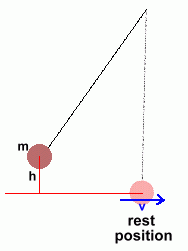  When the mass on the pendulum is pulled back to some angle, it is above the rest level. This gives it additional potential energy EP, which can be measured using the equation
When the mass on the pendulum is pulled back to some angle, it is above the rest level. This gives it additional potential energy EP, which can be measured using the equationWhen the mass passes through the lowest point, it is moving with velocity v, and all of its potential energy has been converted to kinetic energy (ignoring friction losses). The kinetic energy EK is given by: Since these energies are equal, we can set one equation equal to the other, and see what we can solve for. This will give us some useful new formulas. Since EK equals EP as the pendulum passes through rest position: Alternately, we could solve the equation for g:  This gives us a way to measure the value of g, which, as you remember from the previous page, is not really constant. All we need to do is set up a pendulum and measure its velocity as it passes through the rest point, after releasing it from a |